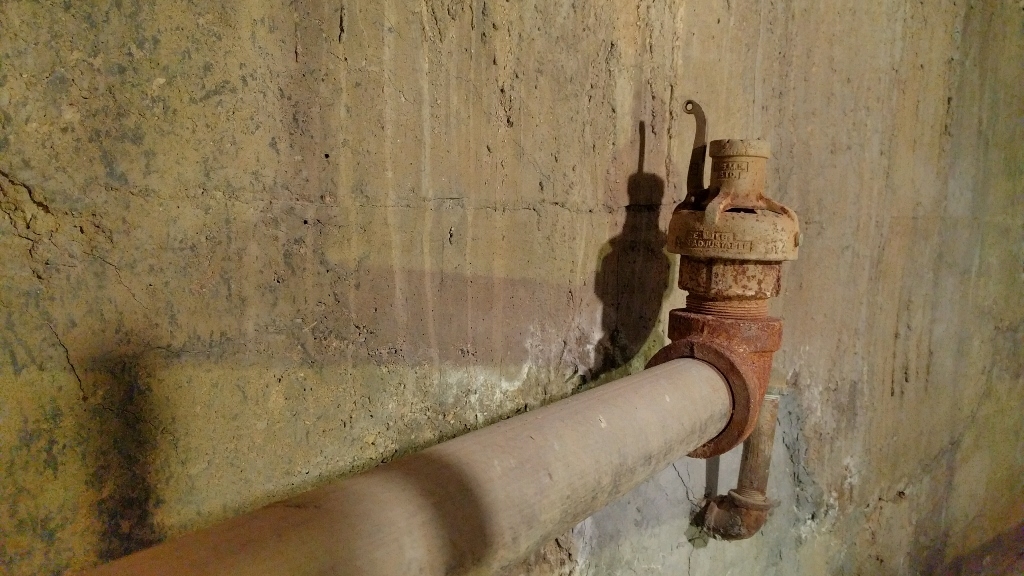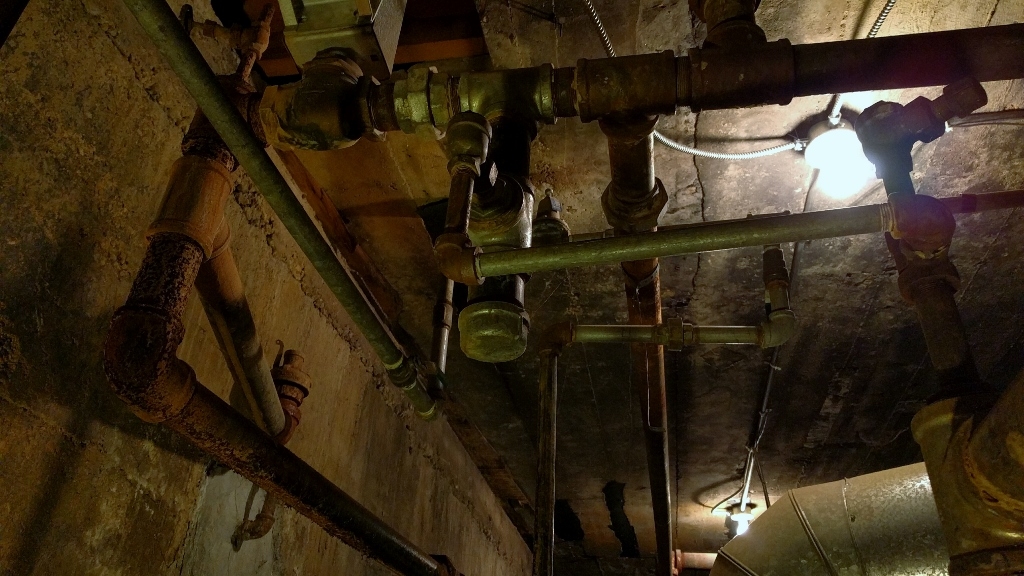Peerless 211A

Comments
-
Any chance this used to be served from a district-steam system? Those pipes coming out of the wall look interesting...........All Steamed Up, Inc.
Towson, MD, USA
Steam, Vapor & Hot-Water Heating Specialists
Oil & Gas Burner Service
Consulting0 -
No district steam here (unfortunately.) Those pipes may have fed some kind of outbuilding, or carried fresh water from the well. The carcass of an old snowman still guards the stairs leading to the boiler pit:

The Honeywell valve looks almost like a metering valve for a high pressure boiler feeding a low pressure distribution system, but the operating Pressuretrol is cranked down as far as it will go.
I'm toying with the idea of a Paul retrofit for this, but I want at least one season of normal operation to observe and tune what's already there. The flue pipe was routed straight up through the butler's pantry and an upstairs room -- so we plan to abandon it, line the chimney, and add a barometric as the first steps in what looks like it will probably be a 20-year restoration project on the whole building.0 -
My 211a has the supply connections at the side of the block, so they must have changed the design sometime between 1991, and 2007. I'm surprised they didn't give the revised design a new model designation.--NBC
http://www.peerlessboilers.com/DesktopModules/Bring2mind/DMX/Download.aspx?EntryId=85&PortalId=0&DownloadMethod=attachment0 -
I noticed that in the IOM. Both Peerless tech support and the rep told me the castings used in 1990 were the same as those in the current 211A. Assuming that's true, it looks like they used an intermediate section as the steam outlet instead of the end tapping. The rep has had the line since at least the late 1950's, so there's a good chance they still have a copy of the correct IOM someplace.0
-
More info, and a couple of questions. Peerless rep says the top tappings on the end sections were at one time used for steam supplies on the smaller 211A's. A single 3" tapping gives us something like 58 FPS at 1/2 PSI (after derating for altitude) and hits its first elbow roughly 18" above normal waterline:
 A few feet sideways and we slam into a 2" x 3" bull-headed tee, increasing the steam velocity to roughly 127 FPS (assuming it can negotiate the turn.) Then we pipe it through three more 90's, routing (via an electric zone valve) to a 2" header of sorts that feeds two 2" mains,
A few feet sideways and we slam into a 2" x 3" bull-headed tee, increasing the steam velocity to roughly 127 FPS (assuming it can negotiate the turn.) Then we pipe it through three more 90's, routing (via an electric zone valve) to a 2" header of sorts that feeds two 2" mains, one of which connects to an original 3" main
one of which connects to an original 3" main At this point I begin to get confused. Another old 3" main connects via a concentric reducer to a 2" line
At this point I begin to get confused. Another old 3" main connects via a concentric reducer to a 2" line which enters the boiler room passing by something impersonating a main vent
which enters the boiler room passing by something impersonating a main vent on its way to the vapor side of the condensate pump
on its way to the vapor side of the condensate pump I'm not sure how steam is supposed to reach this main at all. There's some strange crossover piping (with capped traps) between things in this area and I'm genuinely mystified as to how it's supposed to work.
I'm not sure how steam is supposed to reach this main at all. There's some strange crossover piping (with capped traps) between things in this area and I'm genuinely mystified as to how it's supposed to work.
I fired the boiler today, and it took 20+ minutes to heat the first section of a rad almost directly overhead, in the center of the house. After an hour of running there were still at least five rads which had not heated at all.0 -
That supply piping probably shot lots of water up into the mains, while steaming, which caused the condensate pump to be installed.
It's installations like this which have given steam heating such a bad name over the years. I wonder if the installers of the boiler are still in business. Can you get the previous gas consumption records? Is the radiator EDR a good match for the boiler?
It's a tribute to the Peerless gasketed section design that the boiler still holds water!
One benefit of having the unneeded condensate tank and tank might have been the tempering, and de-oxygenation of the fresh feed water, keeping the block from rusting out.--NBC0 -
No EDR survey yet. Seller says a local mechanical contractor "rebuiIt the boiler" a couple years back. Looks like he replaced both LWCOs and piped the PRV discharge up and out of the basement. A set of instructions were pasted on the side of the boiler, but no records of water usage. Sight glass leaks, so they left it shut off.
I've requested copies of the gas bills.
I'm hoping @Steamhead might be able to clue me in on the motorized zone valve and the bizarre piping. This valve
is at the end of a three foot arm off the vertical portion of the main before it hits the zone valve. It looks like it may have been intended to relieve pressure when the zone valve closed. Talk about a way to kill a boiler...
It looks like it may have been intended to relieve pressure when the zone valve closed. Talk about a way to kill a boiler...
0 -
SWEI said:
No district steam here (unfortunately.) Those pipes may have fed some kind of outbuilding, or carried fresh water from the well. The carcass of an old snowman still guards the stairs leading to the boiler pit:

The Honeywell valve looks almost like a metering valve for a high pressure boiler feeding a low pressure distribution system, but the operating Pressuretrol is cranked down as far as it will go.
I'm toying with the idea of a Paul retrofit for this, but I want at least one season of normal operation to observe and tune what's already there. The flue pipe was routed straight up through the butler's pantry and an upstairs room -- so we plan to abandon it, line the chimney, and add a barometric as the first steps in what looks like it will probably be a 20-year restoration project on the whole building.
I'm sorry, but the first thing I thought of when I saw that boiler was "It's just a flesh wound".Single pipe 392sqft system with an EG-40 rated for 325sqft and it's silent and balanced at all times.
2 -
Well, I hope you have a good stock of Sawzall blades. You'll need them.
There doesn't appear to be any need for the zone valve the way the system is set up now. I think there was something else involved there years ago but it's no longer active. The zone valve can go, as well as that capped-off trap.
The boiler will need to be completely repiped. Get the diagram from Peerless if you don't already have it. Each steam main must have its own takeoff from the header, and I would make the header one size larger than the largest steam main. Since you have at least one 3" main, you'll probably end up using a 4" header.
The concentric reducer needs to be replaced with an eccentric reducer. Yes, you can still get them.
Once you do all this, I'd bet the system runs fine on gravity return with low pressures, so you can ditch the condensate pump and any traps associated with it.All Steamed Up, Inc.
Towson, MD, USA
Steam, Vapor & Hot-Water Heating Specialists
Oil & Gas Burner Service
Consulting0 -
Thanks, Frank. Pretty much where we planned to start, but always good to have a more experienced set of eyes on it.
Single 3" top tapping on end section. No knockouts on end panels or top panel for another riser. The second gas valve being motorized (instead of solenoid, like the primary) was at the time (and may well still be) a local Denver requirement. Rep tells me they used to stock popular 211A sizes in Denver. Boiler manufactured November 1990. I'm imagining a somewhat desperate call from a wholesaler around February 1991: It's cold out. There's no heat in the girls' dormitory. Turns out the Denver rep has a water trimmed 211A in stock -- a little bigger than the job actually needs, but hey -- it's in stock. Rep grabs a box labeled "steam trim" from another boiler and puts it on the pallet with the 211A. It's on the job two days later and everyone gets paid.
Opening up both 6" end tappings would be great, especially for skimming. I'm not sure what to expect trying to break those loose after 25 years of operation. At a minimum, I would open up the 3" top tapping on the other end section and bring both risers up at least 4 feet, then drop down into a 5" or 6" header that will feed all of the building mains.0 -
The 5 inch plugs on the sides would be a chore to remove, so perhaps best to leave them alone, especially with a boiler of that age. You may want to leave two extra tees plugged with nipples and caps, (for easy later removal) in the header for an asymmetrical two boiler setup later when that one dies. I think a welded header could be used, as long as the risers, and drops have long enough legs to absorb any expansion and contraction.
The second top riser tapping has the PRV on it, which could be moved to a tee on the new riser.
Is there a skim port on the old girl? Careful cleaning of the new pipes will reduce the need for skimming. It's hard to know whether to follow Peerless's recommendations for boiling a watery solution of washing soda before skimming, as that may remove some sludge, now sealing a pinhole. Maybe one of the ports used for the gauge glass/LWCO could serve as the skim port.
One of the advantages of the drop header is its ongoing tendency to segregate any oily water into the wet return, so a tee on the equalizer at waterline height could be used to drain the oils off periodically.-- NBC0 -
No skim port currently visible. Water here is relatively hard, so we tend to see more limed up castings than we do rotted out ones. If/when we replace, I'll probably push for a three pass and a modulating gas gun.
I just reworked my velocity calculations above (I had originally used the net output and not the gross.) 127 FPS through three 90's, wow!0
Categories
- All Categories
- 86.8K THE MAIN WALL
- 3.1K A-C, Heat Pumps & Refrigeration
- 56 Biomass
- 425 Carbon Monoxide Awareness
- 109 Chimneys & Flues
- 2K Domestic Hot Water
- 5.6K Gas Heating
- 105 Geothermal
- 160 Indoor-Air Quality
- 3.6K Oil Heating
- 69 Pipe Deterioration
- 965 Plumbing
- 6.3K Radiant Heating
- 385 Solar
- 15.3K Strictly Steam
- 3.4K Thermostats and Controls
- 54 Water Quality
- 44 Industry Classes
- 47 Job Opportunities
- 18 Recall Announcements



